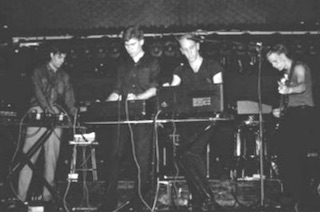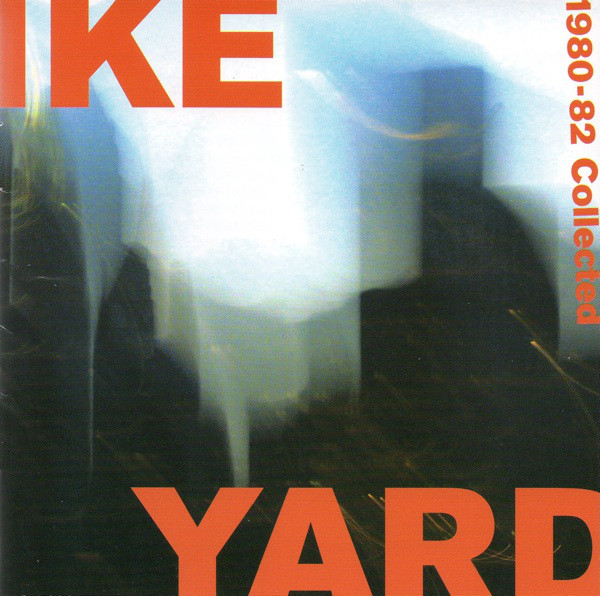Publications > Scream City > Scream City Issue #5 > Factory Over America Part 1 by John Cooper
Factory Over America Part 1
by John Cooper
by John Cooper
Ike Yard were pioneers of the early eighties No Wave scene in New York City and attracted the attention of Factory Records as its nascent international empire spread its wings. Scream City talked to Ike's Stuart Argabright and Michael Diekmann to get the lowdown.
Tell me about the formation of Ike Yard. Were there any particular influences?
[Stuart Argabright] In 1978, keyboard and synth man Martin Fischer from Berlin and I formed The Futants . So then over the next couple years I had days to play around with synthesizers in our rehearsal room on Houston Street. Nights out dancing at the Mudd Club to Warm Leatherette, PIL, Magazine, M, Pop Group. Future Ike Yard member Ken Compton and I would see each other a few times a week down at the Club.
After Ken (bass, vocal) and I (drums, vocal) had been playing awhile, we cast about for other members, found Michael Diekmann (guitar, synth) and Fred Szymanski (synth modules, drum machine, sequencers) through a mutual friend and began the 4 piece Ike Yard.
A few of us were well into Joy Division, the Unknown Pleasures album had resonated over here as well. We had tickets to see them at Tier 3. Within the group we did listen to many things. The German electronic stuff like Pyrolator, Der Plan, Kraftwerk, Bowie and Iggy's Berlin albums, Liaisons Dangereuses, Conny Plank, Mute Records, Fad Gadget, ZTT.
When we started we didn't have a steady space to go to, so when we did we began this intense level of playing and listening concentration, tried to record everything as we would drift far into our own almost private space and sound. Some kind of a pulse or beat would begin and we could entrain to it, through it, around it.
Did you consider yourselves a part of any particular scene or movement?
[SA] After we had been working on our music for a good long time and thought about playing out, Suicide invited us to play with them. Looking back that could have put us in some place, a certain company...
By the time we were more fully electronic for the Factory Album (released in 1982), other electro-art-rock hybrids made impressive first albums; Ultravox! with John Foxx, Gary Numan and Human League pop hits were in the air.
Looking back decades later, the scenes and music genres may appear set - on the ground it amounted to week after week of work; hustling gigs, working to get new equipment enlivened by the occasional 'What, you guys play ELECTRONIC MUSIC!?' from other bands, encounters on the street .
Month by month punk, post punk, electro acoustic, improvisational, production, hardwear, software all evolved.
How did you know about Factory & what lead you to contact them?
[SA] Being our first EP was on the Belgian Crépuscule label, label head Michel Duval was close to the Factory people and next thing we heard our album was going to be on Factory America ...
How was the US wing of Factory run? Was it just a man and a dog in an office or was there a bit more to it than that?
[SA] There was Michael Shamberg and there might have been a dog! Cheers Michael.
[Michael Diekmann] You'd have to speak to Michael Shamberg about the details, but essentially it was just Shamberg (and perhaps assistance from Miranda, and maybe some hourly help) running the label(s) from his loft on 6th Ave.
I don't recall any dog, although there was a barber shop on the floor below. You have to remember though that Factory Manchester was not a huge corporation, just a few blokes with a vision.
How did you know about Factory & what lead you to contact them?
[MD] The initial contact came through Crepuscule. A friend mentioned that he'd read or heard that Crépuscule was interested in recording acts from the US. We were aware of their connection with Factory via Factory/Benelux (especially ACR's Shack Up 45), so after a band meeting, I sent a cassette of several of Ike Yard's demo recordings to Michel Duval at the beginning of 1981. Michel responded a several weeks later saying that he wanted to record us and would soon be visiting NYC.
After he arrived here, he called and we set up a meeting (at a Belgian restaurant in NYC's East Village) to discuss the specifics and offered IY a contract to record an EP.
After searching out an appropriate studio, in April 1981 IY went into Sorcerer Sound on Mercer Street in lower Manhattan with engineer Greg Curry to record a 5 song EP - plus a 6th song for the Crépuscule complation Fruit of the Original Sin, which we ended up not sending to Michel; instead we sent a home-recorded instrumental track emphasizing drum machine and synths.
It was a bit of an "off the wall" choice (considering that we had recorded The Whistler at Sorcerer specifically for the compilation).
Of course Michel didn't know what to make of it and left the track off of Fruit of...
We, as a band, were definitely into pushing the envelope, and retrospectively, it now seems that this 'lost' track may have presaged our more stripped-down electronic style of the Factory album. Ike Yard At this point, I recall that we met with Michael Shamberg (an experimental filmmaker, and boyfriend of Stanton Miranda - who was the other US act recorded by Crépuscule as Thick Pigeon).
My memory is not certain regarding this, but he may have been involved in transferring the monies from Michel Duval to Sorcerer Sound for payment of the recording.
Certainly Shamberg came into the Factory scene via the NYC Crépuscule recordings.
Both Ike Yard and Thick Pigeon recorded at Sorcerer (IY initially, followed by TP a few weeks later). In fact, Fred Szymanski from IY was asked to handle the rhythm programming for the TP song, Sudan on TWI 38 (the A-side, Subway was recorded with keyboardist Carter Burwell - who gained fame later as the soundtrack composer for the Cohen Bros. films).
Around this time, New Order played a couple of gigs in NYC as a 3-piece (at Hurrah's and Tier 3), essentially to fulfill the cancelled Joy Division shows from 1980).
When New Order returned to NYC perform as a 4-piece band at The Ukrainian National Home in November 1981, Ike Yard was asked to open. I recall that Michael Shamberg was involved in the video recording of the show; the New Order footage was released later (Note: after months of trying to track it down, the IY footage was eventually lost at Rebo's, the video recordist's studio).
Although the show was fraught with technical difficulties for IY, a decision was made by Tony Wilson to record an album with the band during the Spring of 1982.
By then, it appeared that Michael Shamberg had become the Factory rep in NYC. The plan was to record albums for both IY and eventually TP, but Factory US/America also released the Live in America Fall LP - as well as re-releasing domestically some of the Factory recordings that had already come out in the UK.
Additionally, Michael S. assisted in facilitating a relationship between the NYC club scene and Factory - which eventually bloomed into the John Robie/Arthur Baker produced New Order 45, Confusion.
This relationship grew, incidentally, at the same time as Stuart Argabright's involvement with that same club music scene (i.e. Dominatrix: The Dominatrix Sleeps Tonight). Shamberg went on to handle much of the Factory video production work.
How come there were so many different designations of the Factory product? There were Factory US, Of Factory New York and Factory America to name but three.
[MD] Typical Factory mischief. Again, remember, Factory gave a catalog number to almost anything that passed through their doors. Factory America One was the New Order/ Ike Yard gig at the Ukrainian National Home (it probably had another designation in Factory UK).
Did Factory America learn from Factory Records (or vice versa)? Or were they left to their own devices?
[MD] I'm certain that Factory UK's operational style informed the American office, but Shamberg also had his own interests: especially with video production, and also regarding the crossover of US avant-grade visua and conceptuall art scene with music (IY had their own connections with this as well). On the obscure end of this, Shamberg produced a 45 7" single with NYC conceptual artist Lawrence Weiner for the label in 1982 (Look that one up!).
Chimerical, no? Shamberg's artworld conceptualism also was behind the cover design for the IY Factory America album in 1982: silver text on a unique type of paper stock (with the band name and label designation split over the two sides): IKE A Second Followed by: YARD A Fact So that the text wrapped around; the end of the album number coupled with the beginning of the band name, and visa versa.
A conundrum to everyone but a few. The music already seemed to exist in another space/time continuum, and we all thought that the cover design made it a more difficult sell. Honestly, I don't think many people knew what to make of it (and some still call the album A Fact A Second).
--
For more Ike Yard check out the compilation album 1980-82 Collected (Acute Records).
<-- |
Our Man in Germany by John Cooper |
Factory Over America Part 2 by John Cooper |
--> |
Issue 5 index
- A Factory Trip Around the World by Andrew James
- The Absence Of The Object Becomes A Presence You Can Feel by John Cooper
- Shadowplayers: The Rise and Fall of Factory Records by James Nice
- The Distractions by David Quantick
- Closer, Karamazov and K550 by Ian McCartney
- 33°52'38.29"E / 151°13'05.79"S by Matthew Robertson
- Our Man in Germany by John Cooper
- Factory Over America Part 1 by John Cooper
- Factory Over America Part 2 by John Cooper
- Looking From A Hilltop... at Lytham St Annes by David Nolan















